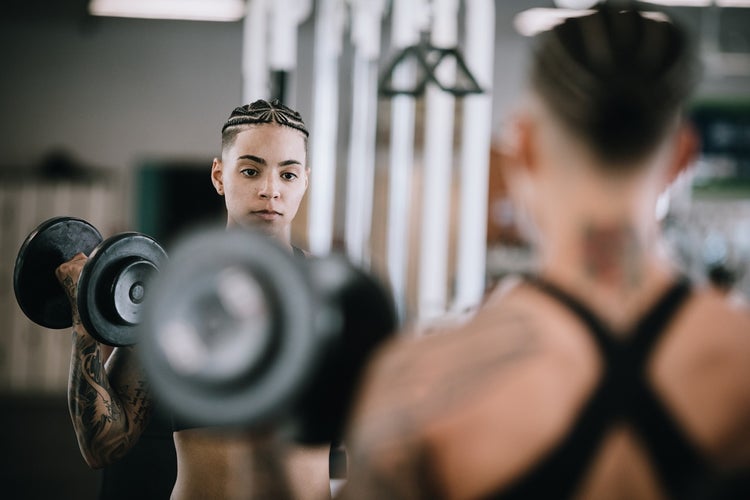Imaginary Strength Training: The Effects of Half the Workout

Imagination is a first step in developing your reality. So imagine pretending to perform biceps curls and actualizing arms like Arnold Schwarzenegger. Suns out, guns out! Or imagine performing squats and developing “quadzilla” legs like Tom Platz (probably worth a Google search).
A 1992 study discovered increases in strength were possible in participants who imagined their training sessions. Researchers measured maximum voluntary contraction (MVC), a measurement of strength defining the maximum amount of force a muscle can generate, held for a short period of time. The researchers reported that the group imagining training sessions for four weeks (20 sessions) increased MVC by 22 percent. The group that actually performed training sessions increased MVC by 30 percent. Not much of a difference, right? So hold on! You can just think about working out and actually get all the muscle strength that comes along with it? The short answer is “yes.” Do I have your attention?
What you think about, you bring about—the short answer
Yes, it is true—you can imagine strength training and harvest some of the effects and benefits. Motor imagery is used in rehabilitation purposes and also used in the area of sports psychology. Motor imagery involves mentally performing an action, like imagining doing a biceps curl. Hence, adaptation occurs in your brain called cortical synchronization. With cortical synchronization, your brain emits neural oscillations, or brain waves sending signals to your biceps as if you’ve actually performed a biceps curl. Sound good so far? Too good to be true? Well, sorry to burst your bubble—let’s get real. You can’t get arms like Schwarzenegger by just thinking about it! As with most things, you get out of it what you put into it—so you’ve got to put in the work. But how about only half the work?
Half the work—the long answer
It’s not an excuse to be lazy. Contralateral strength training may be your solution. Performing only half your strength workouts may still give you strength adaptations. Training one side of the body may strengthen the other side of the body in what is called the contralateral strength training effect (sometimes called cross-education or cross-training). It’s a game plan when time is scarce and you need to fit in a workout.
There are two ways your body gets stronger with only half a body workout. Depending on your brain function, called the neural control systems, you adapt to ipsilateral training, which is training the right arm and right leg, and contralateral training, which is training the opposite (right) arm with the opposite (left) leg.
Have your cup runneth over
Muscular mechanisms, the systems that make your muscles bigger or “swole,” “spill over” to the other side. Hypertrophy or enlargement of a muscle occurs because of hormonal changes in your bloodstream—such as testosterone, growth hormone and IGF-1 (insulin-like growth factor 1)—and because of changes in your muscle protein composition caused by strength training. A 2002 study found that training the arm and opposite left leg resulted in higher blood testosterone and cortisol levels more than those who solely trained the arm alone. Hypertrophy occurs in the side performing the exercise. Although your untrained side will not become as “swole” as the working side, muscles of the untrained side have access to the hormonal changes since the hormones circulate in your bloodstream. Performing a single arm kettlebell snatch on your left arm may strengthen the left side, yet your right side may benefit from the circulating hormones.
In training one side of the body, there is a “spill-over” effect of neural drive to the other side of the body. Neural drive, or the way your brain signals your muscles to move, may be accessed by the untrained side. Another 1992 study found a 32 percent increase in maximum voluntary contraction with the trained leg and a 16 percent increase with the untrained leg after eight weeks of training. So don’t throw in the towel if you’ve sprained an ankle or strained your right knee—go on and train that other side. Thank goodness for TRX single-leg squats!
The glass is half full
We all have a good side—it all has to do with training. If you’re right-handed, your network of connections on the left side of your brain is stronger than the right side of your brain and vice versa. Having a stronger connection on one side of the brain is termed interhemispheric asymmetry. Contralateral strength training may strengthen the callosal connections, or the connections between the right and left sides of the brain.
In contralateral training, try using opposite sides of the body at the same time. But if you’re left-brained and your right-hand side is stronger, use your right brain. Perform ipsilateral movements, same arm and same leg (the left arm with the left leg). If time is short, perform right arm/left leg movements one day and left arm/right leg exercises the next day. Are you confused? It may be time to strengthen the right and left connections of your brain.
Your body and brain will feel the effects of this contralateral workout. Like most training, the frequency, duration, intensity, speed, rest and type of workout will elicit the effects of training. More is not always better, but there are times when some is better than none—like when time is short. It’s the active little steps along the way that keep your health and fitness journey sustainable and truly attainable.
Photo credit: RyanJLane, Getty Images